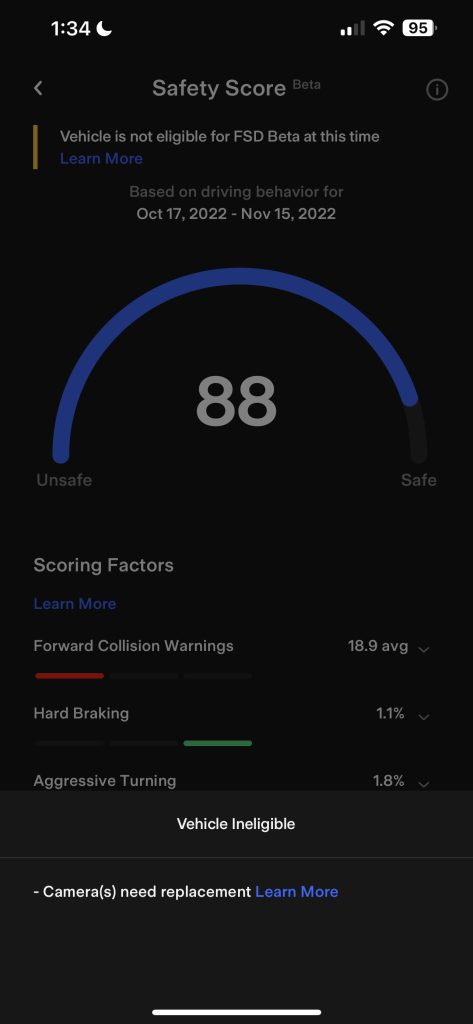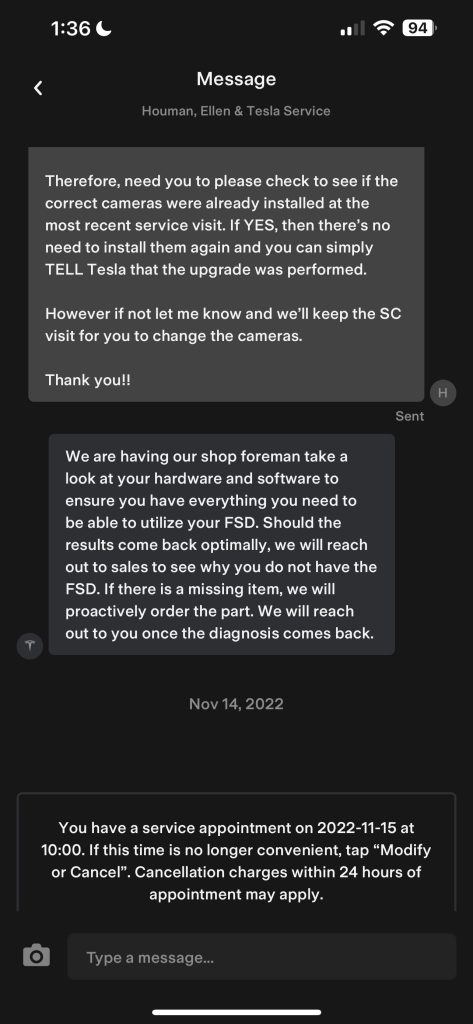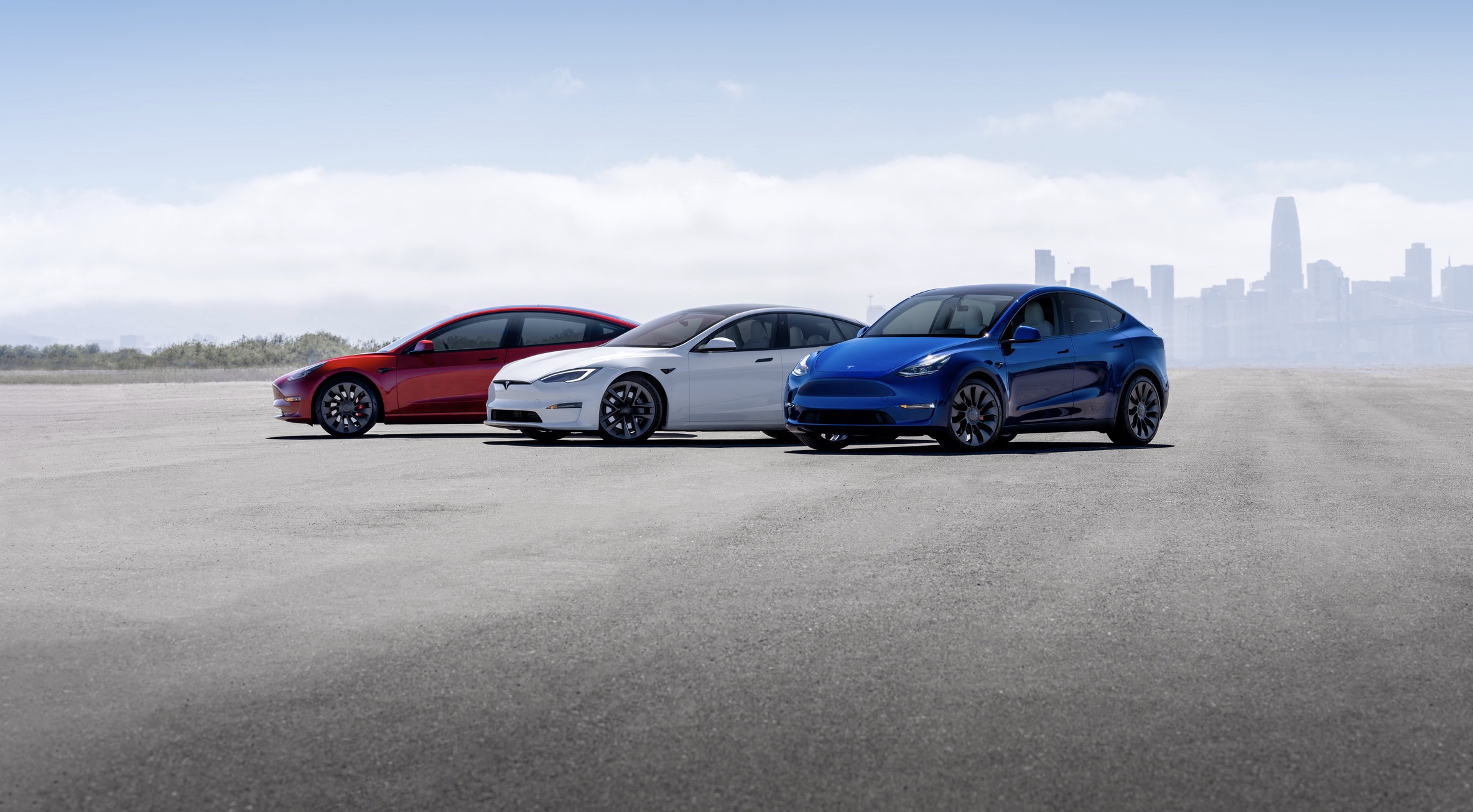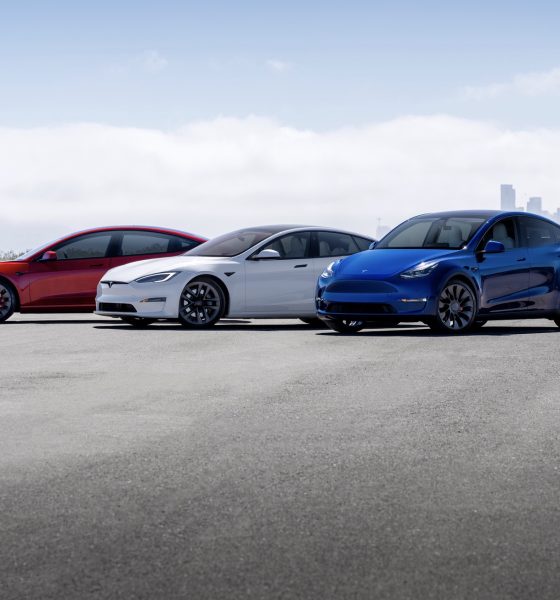Tesla Full Self-Driving (FSD) Beta applicants who own older car models are still patiently waiting for access to the FSD Beta program. Some applicants have shared their frustrations at camera upgrade issues which prevent them from becoming an FSD Beta user.
Camera Upgrade Issues
Tesla owners with older car models have reported their frustrations regarding camera upgrade requirements. Most of the owners are waiting to enter Tesla’s FSD Beta program.
The common issue is that owners receive camera upgrade notifications even after Tesla Service installed new cameras. It has caused great confusion among a number of Tesla community members waiting to become FSD Beta testers.
In correspondence with Teslarati, FSD Beta applicant Houman H. noted that his 2017 Model S with FSD had yet to receive access to Tesla’s Beta program. The Model S owner had upgraded his vehicle to Hardware 3. He also proactively contacted Tesla Service to get the necessary camera upgrade for his car.
Even after the upgrades, Houman H. did not receive FSD Beta access. Instead, he received another notice of his ineligibility for the program, stating that his Model S still needed camera upgrades. Confused, Houman H. contacted Tesla Service, thinking there must have been a mistake in their records as he had already upgraded his cameras.



Who is affected by the Camera Upgrade Issues?
A few Tesla owners who own older models talked to Teslarati about their challenges while patiently waiting for access to the FSD Beta program. Most—if not all—of the owners Teslarati spoke to have a Safety Score between 80 to 90 and purchased FSD at least a year ago.
Most owners with camera upgrade issues own vehicles from 2017 or older. A few other owners have posted about camera upgrade issues online.
“I have been patiently waiting since November 2021 for the FSD beta for my 2017 MS P100D when my cameras were upgraded and the MCU2 was installed. The vehicle was delivered with MCU1 and AP2.0. Safety score has always been 95 or above,” shared Powderkeg in the Tesla Motor Club (TMC) Forum.
“Recently the Tesla app version 4.14.2 allows the user to view if their vehicle is eligible for the FSD Beta. Much to my chagrin my vehicle shows that it is not eligible due to the cameras needing to be replaced. I know they were replaced at the time of the MCU2 upgrade because they are listed under the parts section,” the TMC member elaborated.
Tesla’s Response to the Camera Upgrade Issue
The TMC member and Houman H. worked with their local Tesla Service Center to solve their issues. They received different reasons for their camera upgrade issues.
In Houman H’s case, one of his upgraded cameras needed to be replaced. Tesla reportedly mentioned that some upgraded cameras in select cars needed to be replaced due to an unspecified issue.
“So apparently they didn’t have to replace all of them, they said that there was a problem with one of their replacement cameras that wasn’t working for many people, I think it was the front right side camera so for many of them they had to be replaced Even if they had already been upgraded. Therefore, doesn’t sound like it’s a true situation where all of them have to be replaced, but there are select cameras on select cars that have to be upgraded again due to some type of problem,” Houman H. told Teslarati.
Powderkeg also received information from his local Tesla Service Center. In his case, Tesla stated that all cameras need to be upgraded to run the final production FSD software.

Another Teslarati reader, Frank H., noted that he couldn’t upgrade his cameras, even after several requests to his Tesla Service Center. Frank H. paid for FSD, but has not been able to participate in Tesla’s beta program because of old cameras.
“I paid for FSD years ago but have been unable to participate in the beta program due to old cameras. Now FSD is in wide release and Tesla still has not upgraded my cameras after several requests. I am told: ‘We are currently experiencing a parts shortage on all parts necessary to perform FSD camera upgrade,’” Frank H. shared with Teslarati.
Are you having trouble getting into the FSD Beta program, too? I’d like to hear from you. Contact me at maria@teslarati.com or via Twitter @Writer_01001101.

Elon Musk
Elon Musk’s X will start using a Tesla-like software update strategy
The initiative seems designed to accelerate updates to the social media platform, while maintaining maximum transparency.

Elon Musk’s social media platform X will adopt a Tesla-esque approach to software updates for its algorithm.
The initiative seems designed to accelerate updates to the social media platform, while maintaining maximum transparency.
X’s updates to its updates
As per Musk in a post on X, the social media company will be making a new algorithm to determine what organic and advertising posts are recommended to users. These updates would then be repeated every four weeks.
“We will make the new 𝕏 algorithm, including all code used to determine what organic and advertising posts are recommended to users, open source in 7 days. This will be repeated every 4 weeks, with comprehensive developer notes, to help you understand what changed,” Musk wrote in his post.
The initiative somewhat mirrors Tesla’s over-the-air update model, where vehicle software is regularly refined and pushed to users with detailed release notes. This should allow users to better understand the details of X’s every update and foster a healthy feedback loop for the social media platform.
xAI and X
X, formerly Twitter, has been acquired by Elon Musk’s artificial intelligence startup, xAI last year. Since then, xAI has seen a rapid rise in valuation. Following the company’s the company’s upsized $20 billion Series E funding round, estimates now suggest that xAI is worth tens about $230 to $235 billion. That’s several times larger than Tesla when Elon Musk received his controversial 2018 CEO Performance Award.
As per xAI, the Series E funding round attracted a diverse group of investors, including Valor Equity Partners, Stepstone Group, Fidelity Management & Research Company, Qatar Investment Authority, MGX, and Baron Capital Group, among others. Strategic partners NVIDIA and Cisco Investments also continued support for building the world’s largest GPU clusters.
News
Tesla FSD Supervised wins MotorTrend’s Best Driver Assistance Award
The decision marks a notable reversal for the publication from prior years, with judges citing major real-world improvements that pushed Tesla’s latest FSD software ahead of every competing ADAS system.

Tesla’s Full Self-Driving (Supervised) system has been named the best driver-assistance technology on the market, earning top honors at the 2026 MotorTrend Best Tech Awards.
The decision marks a notable reversal for the publication from prior years, with judges citing major real-world improvements that pushed Tesla’s latest FSD software ahead of every competing ADAS system. And it wasn’t even close.
MotorTrend reverses course
MotorTrend awarded Tesla FSD (Supervised) its 2026 Best Tech Driver Assistance title after extensive testing of the latest v14 software. The publication acknowledged that it had previously criticized earlier versions of FSD for erratic behavior and near-miss incidents, ultimately favoring rivals such as GM’s Super Cruise in earlier evaluations.
According to MotorTrend, the newest iteration of FSD resolved many of those shortcomings. Testers said v14 showed far smoother behavior in complex urban scenarios, including unprotected left turns, traffic circles, emergency vehicles, and dense city streets. While the system still requires constant driver supervision, judges concluded that no other advanced driver-assistance system currently matches its breadth of capability.
Unlike rival systems that rely on combinations of cameras, radar, lidar, and mapped highways, Tesla’s FSD operates using a camera-only approach and is capable of driving on city streets, rural roads, and freeways. MotorTrend stated that pure utility, the ability to handle nearly all road types, ultimately separated FSD from competitors like Ford BlueCruise, GM Super Cruise, and BMW’s Highway Assistant.
High cost and high capability
MotorTrend also addressed FSD’s pricing, which remains significantly higher than rival systems. Tesla currently charges $8,000 for a one-time purchase or $99 per month for a subscription, compared with far lower upfront and subscription costs from other automakers. The publication noted that the premium is justified given FSD’s unmatched scope and continuous software evolution.
Safety remained a central focus of the evaluation. While testers reported collision-free operation over thousands of miles, they noted ongoing concerns around FSD’s configurable driving modes, including options that allow aggressive driving and speeds beyond posted limits. MotorTrend emphasized that, like all Level 2 systems, FSD still depends on a fully attentive human driver at all times.
Despite those caveats, the publication concluded that Tesla’s rapid software progress fundamentally reshaped the competitive landscape. For drivers seeking the most capable hands-on driver-assistance system available today, MotorTrend concluded Tesla FSD (Supervised) now stands alone at the top.
News
Elon Musk’s Grokipedia surges to 5.6M articles, almost 79% of English Wikipedia
The explosive growth marks a major milestone for the AI-powered online encyclopedia, which was launched by Elon Musk’s xAI just months ago.

Elon Musk’s Grokipedia has grown to an impressive 5,615,201 articles as of today, closing in on 79% of the English Wikipedia’s current total of 7,119,376 articles.
The explosive growth marks a major milestone for the AI-powered online encyclopedia, which was launched by Elon Musk’s xAI just months ago. Needless to say, it would only be a matter of time before Grokipedia exceeds English Wikipedia in sheer volume.
Grokipedia’s rapid growth
xAI’s vision for Grokipedia emphasizes neutrality, while Grok’s reasoning capabilities allow for fast drafting and fact-checking. When Elon Musk announced the initiative in late September 2025, he noted that Grokipedia would be an improvement to Wikipedia because it would be designed to avoid bias.
At the time, Musk noted that Grokipedia “is a necessary step towards the xAI goal of understanding the Universe.”
Grokipedia was launched in late October, and while xAI was careful to list it only as Version 0.1 at the time, the online encyclopedia immediately earned praise. Wikipedia co-founder Larry Sanger highlighted the project’s innovative approach, noting how it leverages AI to fill knowledge gaps and enable rapid updates. Netizens also observed how Grokipedia tends to present articles in a more objective manner compared to Wikipedia, which is edited by humans.
Elon Musk’s ambitious plans
With 5,615,201 total articles, Grokipedia has now grown to almost 79% of English Wikipedia’s article base. This is incredibly quick, though Grokipedia remains text-only for now. xAI, for its part, has now updated the online encyclopedia’s iteration to v0.2.
Elon Musk has shared bold ideas for Grokipedia, including sending a record of the entire knowledge base to space as part of xAI’s mission to preserve and expand human understanding. At some point, Musk stated that Grokipedia will be renamed to Encyclopedia Galactica, and it will be sent to the cosmos.
“When Grokipedia is good enough (long way to go), we will change the name to Encyclopedia Galactica. It will be an open source distillation of all knowledge, including audio, images and video. Join xAI to help build the sci-fi version of the Library of Alexandria!” Musk wrote, adding in a later post that “Copies will be etched in stone and sent to the Moon, Mars and beyond. This time, it will not be lost.”










